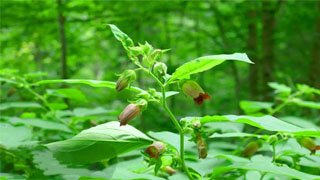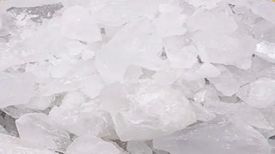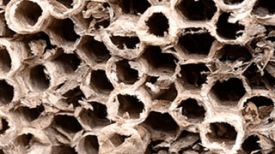
Nicknames: Beauty Grass, Beladona Grass
Harvesting and processing: It can be harvested 2-3 times a year. At the end of June, when the aboveground ridge is closed, the lower old leaves are harvested for better ventilation and light transmission. Collect the second crop in July, leaving about 20cm of stubble. Cut off the aboveground parts and dig roots in August. Dry separately or at a low temperature of 60 ℃ for later use.
Medicinal parts: whole plant
Origin: Originating from central, fermented grains, and southern Europe. Introduction and cultivation of medicinal plants in the north and south of China
Family: Solanaceae
Original plant: belladonna
Plant condition: Perennial herb or 1-year-old due to cultivation
0.5-2m high. The root is thick and cylindrical. The stem is upright, with forked branches on the upper part.
Leaves alternate or grow one large and one small at the top of the stem; The petiole is up to 4cm long and grows distant hairs when young; The leaves are ovate, ovate elliptical, or elliptical in shape, with a length of 7-25cm and a width of 3-12cm. The tip is gradually pointed or sharply pointed, and the base is wedge-shaped and extends downwards to the petiole. The upper part is dark green or green, and the lower part is light green. There are soft hairs along the leaf veins on both sides.
The flower grows alone on the leaves, drooping downwards, and densely covered with white glandular hairs; Calyx bell shaped, about half the length of the corolla, 5-lobed, with triangular lobes, slightly enlarged into a starry shape when fruiting and expanding outward; The corolla is cylindrical and bell shaped, with a yellow green lower part and a light purple upper part. It is 2.5-3cm long and has a diameter of about 1.5cm. The middle of the tube is slightly enlarged, with 5 shallow lobes and ovate triangular lobes; Stamen 5, equally long, slightly shorter than corolla; The flower disk is wound around the base of the ovary; Ovary 2-chambered, style filamentous, stigma greenish, 2-lobed.
The berry is spherical in shape, with a diameter of 1.5-2cm. After maturity, it is purple black, smooth, and has a purple juice. The seed is flattened kidney shaped and brown in color. The flowering and fruiting period is from June to September.
Characteristics of Platycodon grandiflorus medicinal herb: "Characteristic identification: The root is cylindrical, slightly twisted, with a diameter of 5-15mm, a light gray brown surface, longitudinal wrinkles, and occasional branch root marks. The old root is hard and woody; the fine root is brittle and easy to break, the section is flat, the skin is narrow, gray white, the wood part is wide, brownish yellow, and the layer ring pattern is obvious. It has a slight odor, bitter taste, and pungent. The stem is flat cylindrical, with a diameter of 3-6mm, a yellow green surface, fine longitudinal wrinkles, dotted skin holes, sparse distribution, hollow section, and hairy young stem. The leaves are intermingled, often two pieces of different sizes gather in one place, often wrinkled and broken, and intact ones are broadly oval or oval shaped, with a length of 5-22cm and a width of 3.5-11cm. The tip gradually tips, the base gradually narrows, the entire margin, the surface is yellow green to dark brown, with a few hairy hairs on both sides, and more along the leaf veins. When examining the leaf surface with a magnifying glass, small light colored sand crystal cells can sometimes be seen; The petiole is 0.5-4cm long. Thin and brittle in texture. The leaf axils often have flowers and young fruits. The flower is 2.5-3.5cm long, with a 5-lobed sepal and a nearly bell shaped corolla that is 5-lobed. It is dark purple or dark yellow in color. Berry spherical, green to brown, diameter 5-8mm, with a long stem; The seeds are mostly in the shape of flattened kidneys. Qi is subtle, with a slightly bitter and spicy taste.
Excellent products are best with intact leaves and tender stems.
The medicinal properties of belladonna:
【 Indications and Functions 】 Relieve spasms and relieve pain; Inhibit secretion. Ulcers in the main stomach and twelve fingers; Gastrointestinal tract; Kidney; Gallbladder colic; Disgust; night sweat; Drooling
[Usage and Dosage] Oral administration: Tinctures or tablets, refer to the "Preparations" section.
【 Attention 】 Glaucoma patients are prohibited from taking it.
【 Preparations 】 Atractylodes mixture, Atractylodes extract, Atractylodes liquid extract, Atractylodes tablets, Compound Atractylodes tablets. "
【 Indications and Functions 】 Relieve spasms, relieve pain, stop secretion, and dilate pupils. Mainly used to stop night sweats, drooling, excessive bronchial secretion, excessive stomach acid, and relax gastric muscles, relieve spasms in the cardia and pylorus, stop spasmodic cough, and alleviate abdominal cramps caused by laxatives.
【 Usage and Dosage 】 Commonly used as tinctures or tablets in medicine


